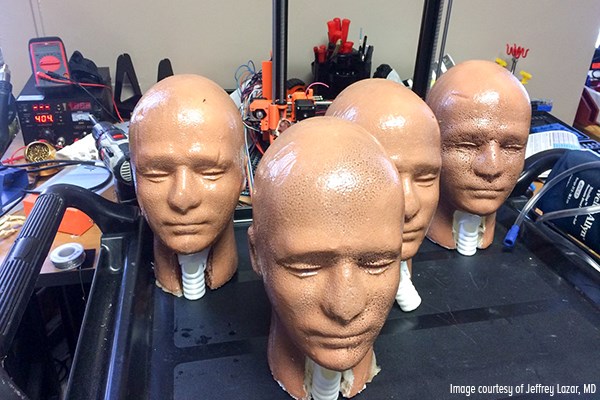In the academic offices of Mina Attaalla, DO, and Jeffrey Lazar, MD, machines whir, gears turn, and belts track along their X, Y, and Z axes, often running for hours or days before finishing their product… which today is a 3-D printed cricothyrotomy trainer. Over time, more of these devices appear. Soon, the tracheas are implanted into foam heads, layered with realistically tinted artificial skin – and voila: an incredibly realistic human neck.
At St. Barnabas Hospital in the Bronx, Dr. Attaalla serves as the Department of Emergency Medicine’s Director of Simulation Education and Informatics. He is spearheading the use of 3-D printing as means to create training devices that can improve the procedural techniques of St. Barnabas’s Emergency Medicine residents. He first became interested in 3-D printing as a result of his obsession with all things technological. After watching a YouTube video of someone 3-D printing a skull, he asked himself if the same technology could be used to teach residents.
Dr. Lazar, Vice Chair and Medical Director of Emergency Medicine, who was already a bit of a maker and an artist with experience in wood and stone carving, metal sculpture, laser and electronic cutting, was introduced to the world of 3-D printing by Dr. Attaalla. Together, they have already purchased several 3-D printers and are making exciting use of them in the field of medical education.
Cricothyrotomy trainers are just the beginning. Dr. Attaalla has produced a design for cutting out a piece of a simulation mannequin’s leg and placing a 3-D printed tibia inside, overlaid with artificial skin to develop an IO trainer. “We are working on logistics of printing ED thoracotomy and thoracostomy models, as well as joint reduction, IO placement, and possibly for our surgical resident colleagues a laparoscopic playground simulation,” Dr. Attaalla said.
Dr. Lazar added, “We are looking into bone and joint creation to study and simulate the management of fractures and dislocations, and we are fine-tuning our simulated spine for lumbar puncture training.” Considering the cost of pre-built training devices, often hundreds of dollars each, 3-D printing offers a significant cost-saving approach to training.
For those who are interested, entry-level printers can be purchased for as little as $250, with filament (the actual printing material) costing as little as $15 dollars per spool. But there is a learning curve and an ongoing investment of time, Dr. Lazar warns: “3-D printers are still at a stage where they seem to require some technological aptitude, and the interest/dedication of a hobbyist.” Troubleshooting 3-D printers definitely requires research and commitment.
Despite the current challenges, early adopters in the medical sim world will not find themselves alone, Dr. Attaalla said. “One of the other reasons I love 3-D printing so much is the wealth of information available for anyone who wants to start doing this now! This includes groups on Facebook, Github, and forum-based sites that help you get started troubleshooting and perfecting the art of 3-D printing.”
Outside of medicine, these devices can be used to make a variety of fun objects. As Dr. Lazar states, “I’ve used 3-D printing for some sculptural projects, including creating molecular models of toxicologic agents, a model of a neuron, and I also recently printed a chimpanzee skull.”
Ultimately, the cricothyrotomy trainers were used during the residency program’s Airway Day to teach a variety of cricothyrotomy techniques. They were well-received by the residents, who said they felt more comfortable with the mechanics of the procedure afterward.
While the airway training is valuable, it is by no means the only application for 3-D printing in medical simulation and education. To quote Dr. Attaalla, “The sky’s the limit! If you can dream it, with time we can probably model and build it.”



